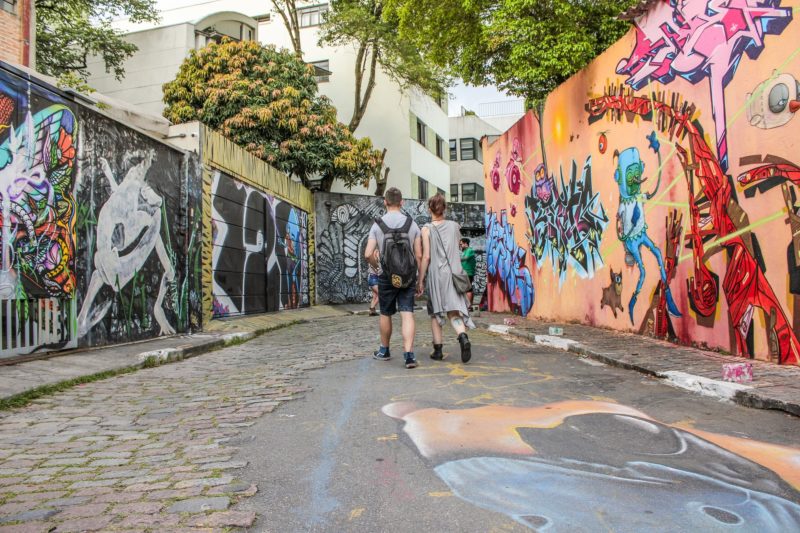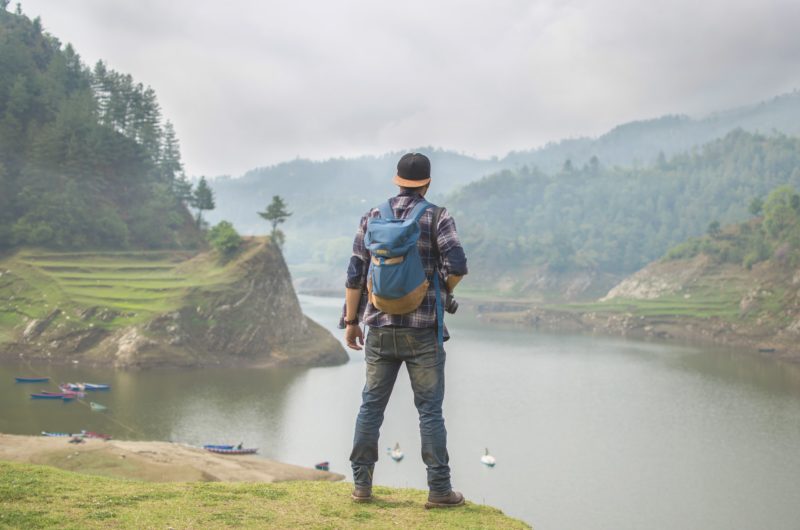You’ve seen it on restaurant signs, beauty products, and even clothing. Those loud words that say “I’m vegan” or “Vegan-friendly”. But now in the context of traveling – what does that mean?
In this article, we’ll take a deep dive into vegan traveling, to learn how veganism relates to sustainability, and if vegan travel is actually doable.
Keep reading to learn more!
Let’s Cover the Basics: What is Veganism?
The Vegan Society defines veganism as a philosophy that seeks to exclude (as much as possible) products that are derived from animals, or which cause harm to animals.
Seems pretty simple, right?
In fact, veganism is not just about eating vegan diet, but a lifestyle. By excluding products that are derived from animals or cause harm to animals, vegans are saying no to leather watches, wool coats, goat’s milk soap (just to name a few), and of course any food items that have animal products in them.
When it comes to vegan traveling, the principle is the same: avoid anything that comes from an animal. It sounds simple in theory, but in practice, veganism can already be difficult in one’s own country, so adding a cultural and language barrier can make it even trickier. But don’t be discouraged! In this article we’ll cover some tips and tricks for traveling as a vegan.
To further add complication, veganism and vegetarianism have different meanings all over the world. For example, in the United States and the United Kingdom, eggs are considered a vegetarian food. They don’t contain “animal flesh” per se, or at least Brits and Americans don’t typically think so. However, hop on a plane to India and you’ll likely find that eggs aren’t part of a vegetarian diet.
While some may find this an inconvenience, it’s actually a great opportunity to learn about the food culture and wealth systems of India. Although it’s often assumed that the majority of Indians follow a vegetarian diet because of their practice of Hinduism, in fact, a survey found that this isn’t the case and that vegetarianism is reserved mainly for the wealthy upper castes.
We’ll save an article on egg consumption in India for the next time, but now that we have a basic understanding of veganism, let’s bring sustainability into the mix.
Veganism and Sustainability: How Do They Relate?

The food you eat has a massive impact on your carbon footprint, plain and simple. Because feeding animals that are butchered requires not just space for animal rearing, but space to grow the food that the animals eat, an omnivorous diet can result in three times more carbon emissions than a vegan one.
Of course, it’s possible to eat vegan food but still produce a lot of waste or have relatively high emissions. This is why it’s important to not only take into account what kinds of foods are being eaten, but where they’re being transported from. Purchasing a bunch of spinach in December in Scotland isn’t great for the environment because it probably had to be flown in, but kale is a hearty winter vegetable and local to Scotland, so it’s a great alternative.
If you really want to reduce your carbon footprint, try eating plant-based and be sure to eat local where possible.
Tips and Tricks for Traveling as a Vegan
Research Local Cuisine Ahead of Time
One of the best tips for vegan traveling is to plan ahead. Research local cuisine that you’ll likely find at restaurants and street carts. Often, you can find something that is traditionally made without meat, eggs, or dairy, especially if you’re traveling in Asia. Asia has some of the world’s best vegan restaurants with authentic vegan food.
For example, a traditional Indonesian snack is Kue nagasari which is a batter wrapped in banana leaves and steamed. It’s made from bananas, rice flour, tapioca starch, coconut milk, vanilla, and sugar. Vegan and delicious!
Local vegetarian and vegan Facebook groups can be a great resource for planning what you’ll eat on your trip. Instagram hashtags like #Vegan[Location] can be very helpful and of course, Happy Cow, an app and website for finding vegan restaurants, continues to be a great resource for vegans on the road. You can save restaurants in the Happy Cow app for later, or you could make your own map with Google’s My Maps to save not just restaurants, but a full detailed trip plan.
Learn the Lingo
Take some time to learn more than “hello”, “thank you”, and “where’s the bathroom” in the language of the location you’re visiting, but also learn words and phrases like:
- Meat
- Chicken
- Fish
- Eggs
- Milk
- Dairy
- I am vegan (not every language has a word for vegan – but more on this later)
- I don’t eat dairy
- I don’t eat meat
There are plenty of amazing language learning tools that are a great place to start. Spend a few weeks learning the basics before your trip. Whether you’re eating plant-based on your travels or not, learning some of the local dialects is a great way to connect with locals and shows that you’re ready to learn and grow as a traveler.
Google Translate to the Rescue
Google Translate is very useful for communicating in foreign countries. The app has features that allow you to use the microphone and have a conversation with another person so both of you can understand – that’s Star Trek level technology!
The photo translation feature is also very helpful and allows you to hold your camera over a menu, ingredients list, etc. as the words are translated to your language of choice on the screen. This feature can be a bit hit or miss, but if nothing else you’ll have a good laugh at the results.
“Meat” and “Vegan” Have Different Meanings
If you’ve seen the movie RV with Robin Williams, you may remember the scene where the daughter is offered meat for dinner and declines, saying that she’s a vegetarian. The man informs her that it doesn’t have any meat in it and so she takes a bite, only to be told a moment later that it’s just innards like intestines, heart, liver, and kidneys. Although it’s meant to be a funny moment, there is some truth to it.
Meat has different meanings around the world. Some people and cultures consider just the flesh of an animal to be meat, while others don’t think of fish or chicken as meat. For this reason, it’s really best to clarify that you don’t eat beef, fish, chicken, etc. This is where having a basic understanding of the language and local dishes can be a big help and time saver.
Similarly, not every language has a word for “vegan”. You may need to say that you don’t eat animal products (although this leaves room for interpretation) or that you’re a vegetarian who doesn’t eat eggs or dairy.
When in Doubt, Stick to the Basics
If you’re ever not sure whether or not something is vegan, stick to the basics: fruit, veggies, beans, and nuts. Bread is also a great go-to, but not always filling and not always vegan because sometimes milk powder or egg gets slipped in there.
Don’t Rely on Eating in Airports
You may think to yourself, “I’ll just wait until I get to the airport” to grab a snack, because surely an international terminal will have something familiar, right?
Not always.
Sadly, relying on airports to find food can result in armfuls of expensive and overly salted peanuts. Instead, stock up on vegan snacks that can make it through security.
Generally, security will let you through with these foods but keep in mind that if you’re flying internationally you may be required to throw away fruits, vegetables, and/or seeds.
- Pre-packaged burritos – It might seem weird, but these typically make it through security and when filled with beans and rice are very filling
- Sandwiches
- Protein bars
- Chips
- Couscous salad – Easy to make from scratch, healthy, filling, and tasty!
Get creative with your snacks and always be prepared to have to throw them out. For this reason, tupperware that you’re not too attached to might be the way to go.
Find Accommodation With a Kitchen

Not only is booking somewhere with a kitchen a more budget-friendly way to travel, it also means that you don’t feel pressured to eat out every night and constantly navigate the “is it vegan or not” conversation.
Remember that a kitchenette isn’t the same as a kitchen and might only provide a fridge and a sink, so be sure to confirm what’s included (you don’t want to have to purchase your own pots and pans) before you book.
Don’t Beat Yourself Up If You Make a Mistake
Last but certainly not least on our tips for vegan traveling is to not beat yourself up if you make a mistake. There are going to be times where you question if what you just ate was vegan or you reread the ingredients to find out that it wasn’t.
Don’t torture yourself.
A big part of traveling is embracing the culture and trying new things and you’re doing just that with ethics and sustainability in mind – good for you!
Which Countries are the Best for Vegan Travelers?
The world is quickly becoming a much more welcoming place for vegan adventurers. The United Kingdom for example has seen an explosion of new vegan products and businesses through Veganuary, a campaign to help people try veganism for the first month of the year. Everyone from small independent businesses to major fast-food chains are offering options for vegans. Similarly, countries like Germany, Sweden, and most major cities in the west are seeing a great vegan scene.
However, there are some countries that have had vegan options long before it was popular. All throughout Asia, it’s easy to find traditional dishes that are accidentally vegan. China and Indonesia are relatively easy for vegan travelers, but Taiwan in particular is a country worth visiting as a vegan destination because a significant amount of vegan meat is produced in Taiwan and the vegan dishes are endless.
Which Countries are the Most Difficult for Plant-Based Travelers?
Although some countries have welcomed veganism with open arms or have had incredible vegan options all along, this, unfortunately, isn’t always the case. While much of the west coast and most major cities in the United States make vegan traveling easy, the rest of the country lags behind. That’s not to say that you won’t find some great vegan eats though. From LA to Boston and even Las Vegas, big cities generally seem to have a broad vegan scene.
In countries like Russia and much of Eastern Europe, it’s also harder (but not impossible) to find vegan options. Don’t be deterred. You’ll always be able to find something to eat. You may just need to do a bit of extra digging during your trip planning stage.
Check Out These Vegan Travelers

Check out these bloggers for specific vegan city guides, tips and tricks for vegan travel, resources, and more.
Voyaging Herbivore
Alysa and Jack are full-time content creators and vegans living in their van, Swanson, as they travel around the UK and Europe. On Voyaging Herbivore, you can find vegan city and product guides, sustainable travel and vegan lifestyle info, and slow van-life travel guides.
My Veggie Travels
Sarah is a Scottish blogger based in Edinburgh but has experience traveling as a vegan around the world. On her blog, My Veggie Travels, you can find guides to visiting animal sanctuaries, vegan airline meal reviews, Edinburgh restaurant reviews, and more.
My Travel Scrapbook
Anna is a sustainable and vegan hiker based in the UK. On her blog, My Travel Scrapbook, you’ll not only find great hiking and nature guides with vegan pitstops thoughtfully added in but vegan guides to cities around the world.
Veggie Visa
Randi of Veggie Visa gives you all things vegan travel and lifestyle. You can find guides to vegan clothing, food, cosmetics, and even a veganism for beginners series.
Veggie Vagabonds
If you’re an outdoor lover, the Veggie Vagabonds, Josh and Sarah, have a guide for you. Their website has all the details on outdoor living from vegan camping essentials to vegan puffer jackets to keep you warm on your adventures.
Toronto Vegetarian Association
If you’re headed to Canada and want to try all the greatest vegan eats, the Toronto Vegetarian Association has a great blog with roundup posts featuring vegetarian and vegan-friendly spots in Canada. It also offers insights to vegan options while traveling outside of Canada as well.
Sustainability Starts with You
Every single day we get up and make a choice about how to live our lives. You can take a big leap towards a more sustainable future through your food choices.
If you want more info on sustainable travel and living, be sure to subscribe to our newsletter to get first access to all the guides and updates straight to your inbox!
Hey reader! Some of the links in this post are affiliate links. This means that if you make a purchase using any of these links, we’ll earn a small commission at no extra cost to you. Hidden Lemur is committed to promoting sustainable travel, and we only partner with brands that we believe contribute positively to that cause.





































